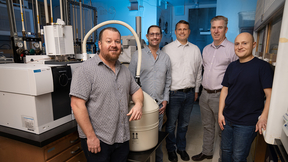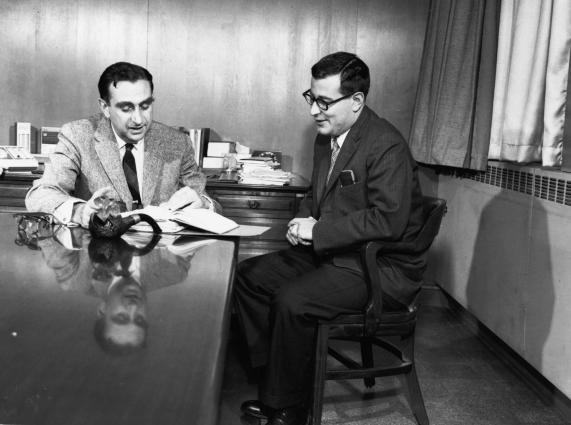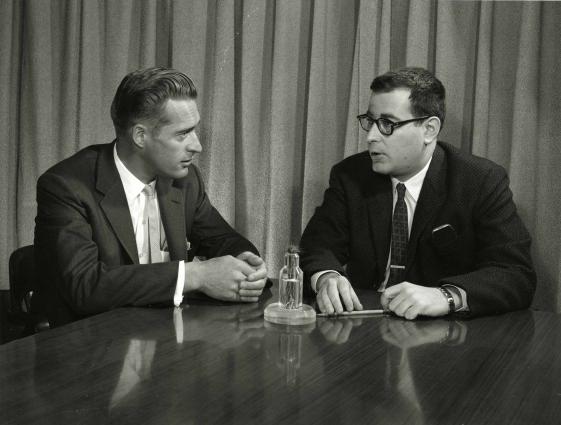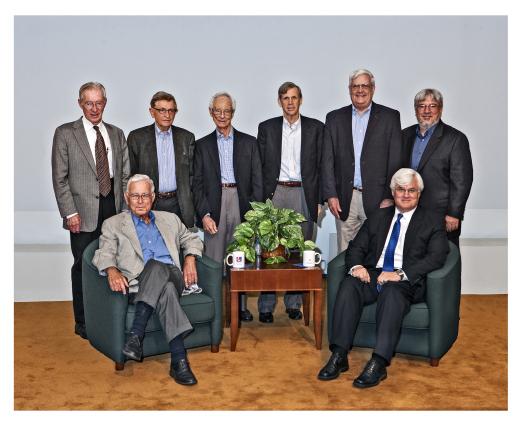Harold Brown: Nuclear deterrence pioneer and former Lab director leaves indelible legacy
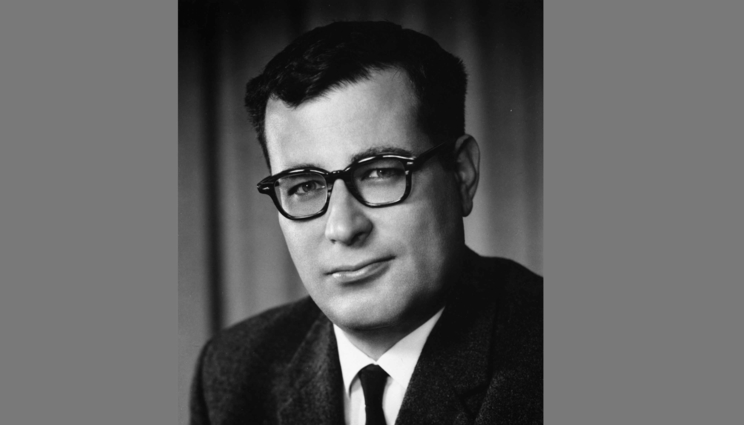 (Download Image)
Harold Brown in the 1950s. The Laboratory's third director passed away Jan. 4
(Download Image)
Harold Brown in the 1950s. The Laboratory's third director passed away Jan. 4
An intellectual giant who led development of technologies that modernized nuclear deterrence and played integral roles during the most dramatic moments of the Cold War while serving under four U.S. presidents, Harold Brown’s life was indelibly intertwined with national security.
The physicist, former Lawrence Livermore National Laboratory director and secretary of Defense under President Jimmy Carter died Jan. 4 at his home in Rancho Santa Fe, California, from pancreatic cancer. He was 91.
"Harold Brown was instrumental in establishing our Laboratory’s reputation for ‘new ideas,’ said LLNL Lab Director Bill Goldstein. "It was through his leadership that Lawrence Livermore developed nuclear weapons that were small and light enough to be placed on submarines, a critical turn for this country during the height of the Cold War. From director of this Lab, to his years working for Presidents Kennedy, Johnson, Nixon and Carter, he always will be remembered for his leadership, his intellect and his commitment to the security of our nation."
Born in in New York City in 1927, Brown displayed a brilliant scientific mind early on in life, graduating from the Bronx High School of Science at the age of 15 with outstanding marks. He studied physics at Columbia University, earning his bachelor’s degree after just two years and holding the highest academic record of any Columbia undergraduate. He received both his master’s and doctorate degrees by the age of 21.
After a stint lecturing at Columbia and the Stevens Institute of Technology and working at the University of California’s Radiation Laboratory in Berkeley, the Atomic Energy Commission recruited Brown to be a research scientist at LLNL (then a UC Rad Lab offshoot) in 1952. In those freewheeling early days, Brown recalled later, the Lab was loosely organized, but operated under a tremendous sense of urgency to quickly develop new warheads capable of countering increasing Soviet aggression and technological advances.
"It was exciting working with (Ernest) Lawrence and (Lab Director Edward) Teller," Brown said during a visit to the Lab in 2013. "I learned something from their successes as well as their mistakes. I learned that you can get things done if you work hard enough and your ideas are good enough…By and large we were very young and inexperienced, but we were able to try new ideas. We had the optimism of youth."
At just 31, Brown became Teller’s deputy, and after severe bouts of colitis befell both Teller and Lawrence, the responsibility of leading the Lab’s weapons program fell squarely on the shoulders of the youthful physicists Brown and Johnny Foster. To counter the perceived Soviet advantage of larger nuclear payloads, as Brown wrote in his memoir "Star-Spangled Security," the U.S. needed to develop lighter, more easily deliverable thermonuclear weapons.
Following some initial failures in 1954, Brown (as a member of the Polaris Steering Committee) led development of a revolutionary light warhead that could be delivered by a missile mounted inside a submarine, a feat thought nearly impossible at the time. The Polaris missile deployed in 1959, a significant achievement coming just two years after the Soviet Union had launched the satellite Sputnik, further heightening tensions between the two superpowers.
"Given complete autonomy, we developed the system in about three years by avoiding external nitpicking and sniping, constant reviews and program revisions," Brown wrote. "The project succeeded in half the normal time."
Foster met Brown while doing his graduate work at the Radiation Lab’s Berkeley site and came to Livermore with him as part of a contingent of postdocs that were transferred over to the new sister facility. He later worked with Brown on the Polaris project and others, succeeding Brown as LLNL’s director in 1961.
"Harold Brown was one of the great leaders of our country, with considerable skill and integrity to match his fortitude and intellect," Foster said. "He was a good friend who will be sorely missed."
George Miller, who served as Lab director from 2007-2011, credited Brown and Foster, along with their colleagues, with creating the modern nuclear weapon, a feat that "changed the nature of the deterrence strategy" and enabled a second-strike capability and a secure American posture that remains to this day. Former Lab Director Bruce Tarter, who wrote "The American Lab," a book on the history of LLNL, said Polaris not only advanced the concept of deterrence but was the key project that positioned the Lab to prove its worth to the country and eventually become the "creator and owner" of the nation’s strategic stockpile in the 1960s and '70s.
"It made the Cold War cold," Tarter said. "All of a sudden you have a collection of nuclear weapons that are unfindable, and that gave substance to the word ‘deterrence.’ Polaris changed the whole geopolitical configuration and gave the Lab a chance to make its bones and demonstrate that its technologies were not only as good as those from Los Alamos, but even added greatly advanced capabilities to nuclear weapons. Polaris created that opportunity."
Foster said Polaris represented a "heroic effort" by Livermore and Sandia engineers and scientists that tipped the scales of nuclear supremacy in favor of the United States.
"It was a marvelous thing," Foster said. "We had the superiority in submarines, we had the standoff capability and we had the thermonuclear warhead that could be delivered. That was revolutionary, and it made all the difference."
At Livermore, Brown became a proponent of arms control, convinced that advancing delivery systems, instead of the weapons themselves, were the most important element in maintaining nuclear balance, according to his memoir. Working with Teller, he helped establish the AEC’s Plowshare Program, aimed at exploring nonmilitary applications of nuclear energy. He also advised American delegates at conferences on nuclear test detections and test bans in Geneva.
Former Lab Director John Nuckolls joined the Lawrence Radiation Lab in 1955 and became one of Brown’s assistants in the Megaton Group (later known as A Division) that designed thermonuclear explosives and experiments. Nuckolls developed computer codes and made calculations for Brown’s designs, and the two men worked together on multiple projects, including high-efficiency thermonuclear weapons, designs for a cannon that could fire a projectile into orbit, new computer codes to calculate underground nuclear explosions, and a below-ground nuclear explosion power plant as part of Plowshare. Nuckolls remembered his former supervisor as a "shy genius" and a "great teacher."
"You could say I that I learned nuclear design from Harold Brown, which turned out to be wonderful because he was an exceedingly brilliant person," Nuckolls said. "He was very good at encouraging people to do what they thought they wanted to do. He would let you learn on your own. There was a lot of freedom."
In 1960, Brown succeeded Teller (at Teller’s recommendation) as the Laboratory’s third director, presiding for about nine months during a moratorium on nuclear weapons testing. As Lab director, Brown continued to advocate for the importance of a nuclear deterrent, balancing the role of nuclear weapons with other elements of deterrence. Brown, according to Miller, also strongly believed the national laboratories should have a continuing role in arms control and nonproliferation, weighing policy goals with technical realities and playing a substantial role in intelligence.
Tarter, LLNL’s director from 1994 to 2002, called Brown an "extraordinary early leader" who, along with the Lab’s first director Herbert York, Teller and Foster, set the institution on a course that brought it to prominence. Brown was a "prodigy," Tarter said, who succeeded not only because he had a technical mind but because he could also play the political game.
"He had enormous self-confidence — some might even call it arrogance — but most of that was justified," Tarter said. "He could balance all the pros and cons and provide cogent arguments. Because he had such a huge intellect and reservoir of knowledge, including the technical pieces, people respected him. He wasn’t just a policy person or running a large organization, he was his own intellectual bodyguard, and that’s pretty rare. He had enough of both sides to make a big impact."
Brown and his wife Colene, who married in 1953, left Livermore for Washington, D.C. in 1961. Brown moved over to the Pentagon, where he served as director of defense research and engineering from 1961 to 1965 under Defense Secretary Robert McNamara, briefing President Kennedy on nuclear weapons. As one of McNamara’s "whiz kids" and the Defense Department’s third-highest ranking civilian, Brown was responsible for weapons development and cemented his reputation as having not only technical expertise, but also a gift for strategic thinking.
President Johnson then appointed Brown as secretary of the Air Force, where he assisted in planning for the Vietnam War and helped develop precision-guided weapons. In 1969, Brown became president of the California Institute of Technology (Caltech) in Pasadena, where he served for the next eight years and was instrumental in admitting the school’s first women undergraduates.
"Whenever he was given an assignment, he would assess the situation and identify the instant problems, then he would implement corrections for those problems," Foster said. "Harold also looked at the future of the organization and his role, whether it was (at LLNL), the Air Force or Caltech, and at the same time he would consider his alternative futures. That’s why he ended up contributing in so many different ways at different organizations, committees and advisory groups."
Brown continued his service to the country as a member of the U.S. delegation to the Strategic Arms Limitation Talks (SALT I), an arms control pact signed in 1972 by President Nixon and Soviet Premier Leonid Brezhnev. In 1973, he became a member of the Trilateral Commission, where he joined with leaders from Europe, North America and Japan to promote political, economic and security cooperation. Brown was President Carter’s choice for defense secretary from 1977 to 1981, the first scientist to hold the position. As secretary, Brown devised a new plan for nuclear deterrence, the "countervailing strategy," a significant departure from the doctrine of "mutually assured destruction" that had reigned since the earliest days of the Cold War. Brown thought the U.S. should develop the capability, through its delivery systems, accuracy and intelligence, of responding to a Russian provocation by attacking the country’s nuclear forces and government, instead of its cities and population centers.
Brown’s tenure would see the Russian invasion of Afghanistan, a revolution in Iran that resulted in the capture of 52 American hostages and the signing of the Camp David Peace Accords. He was the first American secretary of defense to visit China, helping to normalize relations between the two countries. He played a central role in the Panama Canal Treaties and in talks that led to SALT II, a 1979 agreement to restrict Soviet and American missiles and warheads. Though the pact, which Brown saw as vital to détente with Russia, was signed by Carter and Brezhnev, it was never formally ratified by Congress and was essentially scrapped after the Soviets invaded Afghanistan. However, the two countries voluntarily adhered to conditions of the agreement throughout the 1980s.
Near the tail-end of the Carter Administration in 1980, Brown was involved in planning a rescue of the American hostages held in Iran. Brown called the failed attempt, which resulted in the loss of eight American servicemen, "the worst night of my life." Faced with pressure to reduce the defense budget, Brown nonetheless oversaw an increase in the budget, as well as technological advances in ballistic and precision-guided cruise missiles, stealth aircraft, satellite surveillance and communications and intelligence systems.
"These past four years have been rewarding and challenging. But much has been achieved," Brown said in his farewell address. "Most satisfying of all is that for four years our nation remained at peace despite the world tensions and turmoil that constantly pose challenges to our interests and peace."
After leaving the Pentagon in 1981, Brown began a 30-plus year career in the corporate and educational sectors. He taught at the Johns Hopkins University School of Advanced International Studies for several years, and from 1984 to 1992 chaired the school’s Foreign Policy Institute. He also became a trustee (and later trustee emeritus) of the RAND Corporation and joined the Center for Strategic and International Studies as a counselor and trustee in 1992.
"Apart from the obvious technical things he did, one of his biggest legacies was the need to integrate science and technology with political and policy goals," said Miller. "He was really an icon in that particular point of view that I think is often missing in a lot of the debates we see today. The ability to bring that detailed, logical thought to the interface between those different disciplines was one of his rare skills."
President Carter awarded Brown with the Presidential Medal of Freedom in 1981, the highest honor afforded to an American civilian. In 1993, President Bill Clinton presented Brown with the Department of Energy’s Enrico Fermi Medal, one of the most prestigious awards in science and technology, citing him for his "outstanding contributions to national security, leadership in development of nuclear weapons and in formulating nuclear deterrence policy during the difficult Cold War period, and ongoing counsel."
Throughout the decade and into the 2000s, Brown was a partner at the New York private equity firm Warburg Pincus and served as corporate director for more than a dozen businesses, including Mattel, IBM and Cummins Engine. Until his death, Brown continued his involvement in government as a member of the Defense Policy Board, which advises sitting secretaries of defense on strategic, military and international political issues and worked on various government commissions on military strategy, intelligence, innovation and terrorism.
Brown’s memoir, "Star-Spangled Security," was published in 2012, and the following year Brown visited the Laboratory to discuss the book. Addressing modern national security challenges, Brown said the greatest threats were internal, warning that waning notion of American exceptionalism, the increasing gap between rich and poor and political partisanship could all undermine morale. In the book’s conclusion, however, Brown waxed optimistic about the future of the U.S. as a world leader, due to its unique geographic position, natural resources, diversity and flexible political system.
"We have the ability to address what we must to remain strong and prosperous," Brown wrote. "It is no small challenge, but we are not a nation of small aspirations. We are a nation of people who get things done. We have brought the flag through perilous fights. Now, it falls on each of us to join in protecting our interests abroad while guarding values that embody the rights and duties of each of us at home. Let’s do it."
Brown is survived by daughters Deborah and Ellen Brown; a sister, Leila Brennet; and two grandchildren. His wife Colene preceded him in death in 2018.
Contact
 Jeremy Thomas
Jeremy Thomas
[email protected]
(925) 422-5539
Related Links
Star-Spangled SecurityTags
DefenseFeatured Articles
